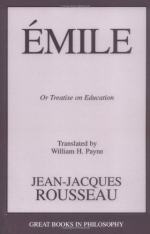Moreover, in this occupation as in others, I do not intend my pupil to play by himself; I mean to make it pleasanter for him by always sharing it with him. He shall have no other rival; but mine will be a continual rivalry, and there will be no risk attaching to it; it will give interest to his pursuits without awaking jealousy between us. I shall follow his example and take up a pencil; at first I shall use it as unskilfully as he. I should be an Apelles if I did not set myself daubing. To begin with, I shall draw a man such as lads draw on walls, a line for each arm, another for each leg, with the fingers longer than the arm. Long after, one or other of us will notice this lack of proportion; we shall observe that the leg is thick, that this thickness varies, that the length of the arm is proportionate to the body. In this improvement I shall either go side by side with my pupil, or so little in advance that he will always overtake me easily and sometimes get ahead of me. We shall get brushes and paints, we shall try to copy the colours of things and their whole appearance, not merely their shape. We shall colour prints, we shall paint, we shall daub; but in all our daubing we shall be searching out the secrets of nature, and whatever we do shall be done under the eye of that master.
We badly needed ornaments for our room, and now we have them ready to our hand. I will have our drawings framed and covered with good glass, so that no one will touch them, and thus seeing them where we put them, each of us has a motive for taking care of his own. I arrange them in order round the room, each drawing repeated some twenty or thirty times, thus showing the author’s progress in each specimen, from the time when the house is merely a rude square, till its front view, its side view, its proportions, its light and shade are all exactly portrayed. These graduations will certainly furnish us with pictures, a source of interest to ourselves and of curiosity to others, which will spur us on to further emulation. The first and roughest drawings I put in very smart gilt frames to show them off; but as the copy becomes more accurate and the drawing really good, I only give it a very plain dark frame; it needs no other ornament than itself, and it would be a pity if the frame distracted the attention which the picture itself deserves. Thus we each aspire to a plain frame, and when we desire to pour scorn on each other’s drawings, we condemn them to a gilded frame. Some day perhaps “the gilt frame” will become a proverb among us, and we shall be surprised to find how many people show what they are really made of by demanding a gilt frame.
I have said already that geometry is beyond the child’s reach; but that is our own fault. We fail to perceive that their method is not ours, that what is for us the art of reasoning, should be for them the art of seeing. Instead of teaching them our way, we should do better to adopt theirs, for our way of learning geometry is quite as much a matter of imagination as of reasoning. When a proposition is enunciated you must imagine the proof; that is, you must discover on what proposition already learnt it depends, and of all the possible deductions from that proposition you must choose just the one required.




